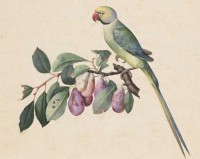By Giulia Bagni (University of Florence)
The exhibition entirely dedicated to Jacopo Ligozzi is visible until 28 September, starts from the Sala Bianca of Palazzo Pitti for advancing within the so-called flat end in the Hall of Tapestries and Sala di Bona.
The exhibition is divided into two clearly distinct sections with the use of different colors for the trim panels that serve as support for the works of art.
The first section, in the case of an intense dark green, covers the first phase of the artist for Francesco I de ‘Medici, who served as a designer of natural products. Also for the Medici were a portraitist, a history painter and a designer of temporary structures for public celebrations.
The second section, characterized by the color blue, takes into account the activity of Jacopo painter of religious subjects which, having executed large altarpieces for churches in Florence and beyond, and his personal reflections on the theme of moral allegories.
For each section there is an introductory panel (in Italian and English) that explains briefly what the visitor will observe. Unfortunately they are placed in passageways where reading can be difficult. Also, the news reports are too generic; many of his works of art are also named in painting where the artist took part, but without that we cannot reconnect the preparatory drawings exposed to the information previously read because the cards placed next to each work (only in Italian!) merely indicate the subject represented, the year, the material and the place of origin.
In a passage that divides the two sections were positioned three monitors that transmit a video designed to illustrate the studies carried out on the occasion of the exhibition of drawings by Ligozzi to identify techniques and materials used.
Another multimedia station is located in the so-called Loggia, frescoed by Alessandro Allori, where a short film provides more details on the works in the exhibition explaining, for example, the destination of the preparatory drawings seen in the room before.
In conclusion, the show is interesting and capable of making the audience discover the brilliance, the versatility and sophistication of this painter, especially with regard to the depiction of natural subjects. Unfortunately, it was not possible to recreate the historical and artistic context in which it moved Ligozzi and it failed to connect properly with his figure to the other artists who worked in the same time at the Medici court.
The exhibition ticket also allows access to the Palatine Gallery and the Gallery of Modern Art in Palazzo Pitti. It is recalled that the Cabinet of Prints and Drawings of the Uffizi are exposed, in conjunction with the exhibition, which include a group of botanical drawings by the hand of Ligozzi.
For more information please visit these websites:
http://www.unannoadarte.it/ligozzi/index.html
http://www.polomuseale.firenze.it/mostre/mostra.php?t=5379efc3f1c3bc4c08000000
Jacopo Ligozzi “pittore universalissimo”
Giulia Bagni (Università di Firenze)
La mostra, interamente dedicata a Jacopo Ligozzi e visibile fino al 28 settembre, prende avvio dalla Sala Bianca di Palazzo Pitti per inoltrarsi all’interno del cosiddetto appartamento degli Arazzi e concludersi nella Sala di Bona.
Il percorso espositivo si articola in due sezioni chiaramente distinte grazie all’uso di colori diversi per i rivestimenti delle pannellature che fungono da supporto per le opere d’arte.
La prima sezione, non a caso di un intenso verde scuro, ripercorre la prima fase dell’attività dell’artista presso Francesco I de’ Medici, che lo stipendiava come disegnatore di naturalia. Sempre per i Medici fu anche ritrattista, pittore di storia e progettista di apparati effimeri per celebrazioni pubbliche.
La seconda sezione, caratterizzata dal colore blu, prende in considerazione l’attività di Jacopo quale pittore di soggetti religiosi, presentando grandi pale d’altare eseguite per chiese fiorentine e non solo, e le sue personali riflessioni sul tema delle allegorie morali.
Per ogni sezione è presente un pannello introduttivo (in italiano e in inglese) che spiega brevemente cosa il visitatore andrà ad osservare ma, oltre che ad essere posizionati in luoghi di passaggio per cui a volte la lettura può essere difficoltosa, le notizie riportate sono troppo generiche; inoltre vengono nominate numerose imprese pittoriche a cui l’artista prese parte, senza però che si riesca poi a ricollegare i disegni preparatori esposti alle informazioni precedentemente lette poiché i cartellini posti accanto ad ogni opera (solo in italiano!) si limitano ad indicare il soggetto rappresentato, l’anno, il materiale ed il luogo di provenienza.
In un ambiente di passaggio che divide le due sezioni, sono stati posizionai tre monitor che trasmettono un video volto ad illustrare gli studi compiuti in occasione della mostra su alcuni disegni del Ligozzi per individuare tecniche e materiali utilizzati.
Un’altra postazione multimediale si trova nella cosiddetta Loggetta, affrescata da Alessando Allori, dove un filmato fornisce maggiori dettagli sulle opere presenti in mostra chiarendo, ad esempio, la destinazione dei disegni preparatori visti nelle sale precedenti.
In conclusione la mostra risulta interessante e capace di far scoprire al pubblico la genialità, la versatilità e la raffinatezza di questo pittore, soprattutto per quanto riguarda la raffigurazione di soggetti naturali. Purtroppo però non si è riusciti a ricreare il contesto storico artistico all’interno del quale si muoveva Ligozzi e quindi a collegare adeguatamente la sua figura agli altri artisti che operavano nello stesso tempo alla corte Medicea.
Il biglietto della mostra consente anche l’accesso alla Galleria Palatina e alla Galleria d’arte moderna di Palazzo Pitti. Si ricorda che al Gabinetto delle Stampe e dei disegni degli Uffizi sono esposti, in concomitanza con la mostra, un gruppo di disegni botanici di mano del Ligozzi.
Per ulteriori informazioni visitare i seguenti indirizzi:
http://www.unannoadarte.it/ligozzi/index.html
http://www.polomuseale.firenze.it/mostre/mostra.php?t=5379efc3f1c3bc4c08000000
